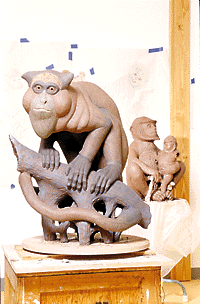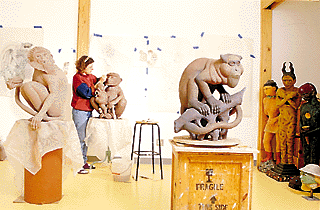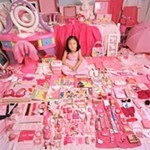Back to Nature
Reviewing New Work by Judy Jensen and Claudia Reese
By Rebecca S. Cohen, Fri., May 16, 1997
|
|
When I first represented her work though R.S. Levy Gallery, Claudia Reese's anthropomorphic sculptures wore wildly colorful and patterned costumes -- stripes, dabs, and squiggles of red, orange, green, blue, and black. According to Reese, they were "cross-cultural, cross-temporal, and contemporary" ceramic figures. They seemed to be metamorphosing into animals or birds, or perhaps they were animals returning to human form. As tall as grade schoolers, initially, the sculptures then escalated in size. Some suggested familiar myths and legends. Others addressed issues of the spirit and our relationship to nature. Their surfaces eventually became more muted in color and rough rather than smoothly glazed.
Since December, Reese has constructed three realistic simian sculptures (a fourth, a baby monkey, clings to its mother) which perch atop extruded clay sewer pipe pedestals with molded concrete pediments and capitals. Reese continues to explore the figure, infusing her work, as always, with visual delight and joy. "The monkeys aren't human, but they have human qualities," says the artist about the new series. She says the inspiration to make these animals came from a family visit to Florida, where she and her son saw monkey colonies maintained on islands, accessible only by boat. When she returned to Austin, the artist borrowed books from the library and then took certain aesthetic liberties to create Old King Louis, Isabella, and Igraine and her son. (Those familiar with Lyons Matrix Gallery's other artists may wonder if the work was intended as a response to the elegantly carved -- and somewhat more sinister-faced -- monkeys carved and painted by David Everett. Reese says no.) Reese is less concerned with specific monkey pedigrees and more engaged with what she sees as their somber, patient demeanor, their human qualities.
|
|
The terra cotta columns on which they sit add a monumental quality to the sculptures. The modestly scaled monkeys are made of a stoneware with "its own yummy brown color," says the artist, referring to the severely limited palette of glazes applied to the surface. Reese says that white clay, the material she once used for her sculpture, called for surface and color and pattern while the brown clay begs to be left alone. The absence of bright glazes on this work and the swirling, barely-colored presence of texture allows the viewer to focus on form. It is a true pleasure to discover Reese's facility in this area. The complexity of surface on her earlier figures often distracted from the way they cut through space. Their grace was hard to perceive amidst the chakras and chalices and exotic headgear and surface designs. The monkeys are different, more graceful.
The monkeys are beautiful.
They are also just a little silly. Old King Louis wears a toothy grin, Isabella huddles above the fray on a branch, Igraine's little one wraps his prehensile tail about mom's tail for security. Each displays a wealth of small and pleasing detail, and begs to be stroked. I am pleased to hear that the artist has "a few more monkeys up her sleeve." I wish there had been more in this exhibition. These newest creatures are so beautifully fashioned that the much older animal heads exhibited in the gallery's front window seem clumsy by comparison -- and unnecessary, except to enhance the total number of sculptures in the gallery. This exhibition proves Reese's fine evolution as a sculptor, but also emphasizes the meandering path she's chosen professionally. Her sculpture production is limited as a result of the hours she spends overseeing Cera-Mix, the company she's created to produce the ceramic plates, platters, and tiles that she designs. Making sculpture, a particularly time-consuming enterprise, clearly does not receive the bulk of her attention.
Three gloriously patterned and brightly colored Cera-Mix tile columns complete the show, along with two green plants which attempt to create a jungle-like environment for the monkeys atop their pedestals. Perhaps if the gallery walls had been painted a deep color and more dramatic lighting had been provided, these creatures might have appeared as if they too were stranded on an island of their own. Missed opportunity. Potential collectors need not worry, however, that the monkeys require excessive care and feeding (or lighting). Reese's newest sculptures can be displayed indoors or out.
 |  |
| "Byzantium" and "New World" by Judy Jensen | |
Judy Jensen presents a huge body of work created over three years time. She is a fine painter whose often complex, always mysterious images are applied on the back of shaped or rectilinear pieces of glass. She works in reverse, layering acrylic paint, oil pastel smudges, and gold or metal leaf. Then she sprays the paint with black enamel to seal it. Her images push forward against the "right" side of the glass, appearing to fuse with the smooth surface. The viewer sees but has no access to Jensen's flora and fauna, virgins and vixens, and celestial bodies, all rendered with painterly aplomb. The artist draws not quite as well as she paints, but there are no serious distractions from the expert application of her brush strokes.
In the front gallery, Jensen's shaped constructions loom large on the wall. Sometimes they seem to elbow one another in this exhibition like too many children in the back seat of a Suburban. They are most effective engaged one on one, in a more private dialogue. Paradise -- a stack of lava rocks with a single sexy red anthurium draped on top -- won my attention immediately. Like the artist, I've traveled to Hawaii and fallen in love with the flowers, birds, black sand beaches, and the islands themselves, still growing beneath the ocean. One of the most lovely images in the show is a picture postcard that leans against this stack of rocks. On it, Jensen has painted exotic birds and plants. Another postcard, this one featuring a seashell, perches on top of the rocks. Near Paradise, Jensen's work called Gardens calls for attention, too. It is shaped like a pitchfork with two small pictures mounted on its tines. The luminous colors in this and every other work, small or large, appear more as colored light than pigment.
Jensen says, "I've painted on paper and wood -- just a few pictures on canvas -- since I was a child." A brief flirtation with making leaded glass windows resulted in the artist's applying paint to glass in order to achieve a certain color, to detail an image. Then she "dropped the leading" and perfected the technique she currently employs in works both large and small. A long row of small rectangular paintings with ornate picture frames presents an overview of Jensen's imagery and technique. The viewer peers into each one as if it was a peep hole into a wild and magical world lying just beyond the wall.
"Wild Life" will be exhibited at Lyons Matrix Gallery through May 24.










